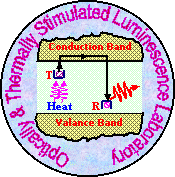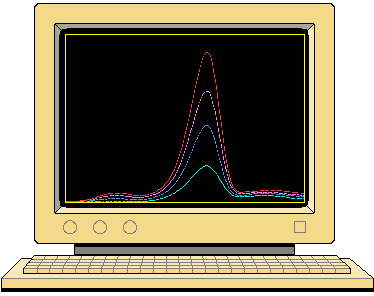1. What is ionizing and non-ionizing radiation?
Radiation is the transport of energy by electromagnetic waves or atomic
particles. There are two types of radiation, ionizing and non-ionizing.
Ionizing radiations carry enough energy to break chemical bonds and separate
electrons from the parent atoms and molecules, thereby creating ions in
the irradiated material. Ionizing radiation consists of directly ionizing
and indirectly ionizing radiation. Directly ionizing radiations are charged
particles (electrons, positrons, protons, alpha particles, heavy ions)
with sufficient energy to ionize or excite atoms or molecules. Indirectly
ionizing radiations are uncharged particles (photons, neutrons) that set
in motion directly ionizing radiation (charged particles) or that can initiate
nuclear transformations. Radiation with less energy than that required
to produce ions in the irradiated material, is called non-ionizing radiation.
Ultraviolet radiation (except the high energy end of the UV-spectrum),
visible light, infrared radiation, micro waves and radio waves, are all
non-ionizing. The most common kind of ionizing radiation is also X-rays,
since they are so commonly used in dentistry and medicine. Moving at the
speed of light, X-rays are a penetrating form of radiation, which means
they travel through material easily.

2. What You Should Know About Ionizing Radiation
Here are four key points about ionizing radiation:
The biological effects of radiation are dose-dependent, meaning that
greater amounts cause greater effects.
The effects of a given exposure vary widely from person to person.
It is impossible to predict precisely how any given individual will react
to radiation -- except at lethal levels.
Large quantities of ionizing radiation delivered over seconds, minutes
or a few hours is called an acute radiation exposure. Acute exposure to
the whole body is more dangerous than acute exposure to just a part of
the body.
Scientists are not sure how much harm is done by low doses of radiation
over an extended time period. Some scientists believe that any amount of
exposure can be harmful, that there is no minimum level of radiation that
is not in some way harmful.
Not all scientists agree about the long-term effects of low doses of
radiation and that chronic doses of ionizing radiation may increase your
chances of contracting cancer
3. What is absorbed dose?
The effects of ionizing radiation on matter are initiated by the processes
in which atoms and molecules of the medium are ionized or excited. The
average number of ionizations and excitations is proportional to the amount
of energy given to the medium by ionizing radiation. Absorbed dose is the
amount of energy given to the medium per unit mass. It is measured in gray
(Gy) defined as Joule/kg. The determination of the dose due to radiation
is the task of radiation dosimetry.
4. What is radiation dosimetry?
Dosimetry has the task of absorbed dose determination and its physical
interpretation. Absorbed dose is determined with radiation measurements
and calculations.Different instruments are used for absorbed dose measurements,
all based on the detection of some of the physical and chemical changes
caused by radiation. For example, ionization chambers, calorimeters or
ferrous-sulfate dosimeters measure, respectively, the electrical charge
produced by ionization of a gas inside a detector, the amount of heat produced
by radiation in a piece of material, or the chemical changes in an aqueous
solution of ferrous-sulfate. Most measurements therefore provide an indirect
determination of the dose, and calculations are needed to convert the quantity
measured into absorbed dose.Radiation dosimetry is needed in many areas,
such as in cancer treatment using radiotherapy, in clinical diagnostic
radiology, in environmental radiation protection, and in industrial applications
such as food irradiation and sterilization of health care products.
5. Can the body feel ionizing radiation?
Ionizing radiation cannot be detected by any of our senses, even if
it produces the numerous physical and chemical changes that make possible
to detect radiation. Many of these effects, for example, produce heat,
but not enough to be sensed by the human body. A large absorbed dose of
10 Gy, which would be lethal if delivered in a short time to a human being,
produces a temperature rise of only 0.0024 deg C; the total energy imparted
to a person of 70 kg would only be 700 J. Compare this to the energy of
100 g of light yogurt or in 100 ml juice, about 200,000 J.
6. Do all kinds of ionizing radiation have the same
biological effect on human beings?
The biological effect of ionizing radiation on a human being depends
on the absorbed dose, the radiation quality (i.e. gamma, beta, alpha etc.
and their energy), and on the organ(s) irradiated. Besides, all human beings
are not equally sensitive to radiation, and additional differences in sensitivity
are attributed to age and sex. If we restrict the comparison to the various
qualities of ionizing radiation and keep all other parameters constant,
the biological effect from a single exposure to alpha particle radiation
is about 20 times more than from gamma or beta radiation for the same dose.
The biological effect from neutron radiation varies between 2-10 times
that from gamma or beta radiation depending on the energy of the neutrons.
If the absorbed dose to the different organs in the body and the radiation
quality are known, the effective dose equivalent can be calculated. Based
on the estimates of the effective dose equivalent, the risk for the late
effects such as cancer, can be compared for different exposure conditions
and type of radiation.
7. When and Why Radiation Can Be Dangerous
When you think about radiation, do you picture things like nuclear
bombs or fallout? Nuclear power plants? If so, you may have the impression
that all radiation is dangerous. This is not so. Some kinds of radiation
are completely harmless -- such as light from an ordinary bulb. Yes, light
is a form of radiation.
The type of radiation which we do need to be concerned about is called
ionizing radiation. Ionizing radiation occurs in nature and is also man-made.
It is the type of radiation used in many useful machines including X-ray
equipment.
One of the problems with ionizing radiation is that we cannot see it,
hear it, taste it, smell it, or feel it in any way. This type of radiation
disrupts some of the atoms in its path causing them to separate into electrically
charged ( + and - ) components called ions. This is why it is called ionizing
radiation.
Ionizing radiation's ability to break atoms makes it different from
other types of radiation. Since our bodies are made of atoms, ionizing
radiation can be harmful to living tissue. The atoms in our bodies become
biologically useless if divided into ions. Trillions of atoms exist in
our bodies and if a few of them are ionized, we suffer no real harm. But
large doses of ionizing radiation can cause sickness, cancer and birth
defects.
Some scientists believe that long term exposure to even small amounts
of ionizing radiation can cause similar problems. This is known as the
Linear Non-Threshold Theory.
8. What are the colour centers?
Pure alkali halide crystals are transparent throughout the visible
region of the spectrum. The crystals may be colored in a number of ways
(1) by the introduction of chemical
impurities
(2) by introducing an excess of the
metal ion
(3) by X-ray, g-ray, neutron and electron
bombardment
(4) by electrolysis
A colour centre is a lattice defect that absorbs visible light. The
simplest colour center is an F-centre. The name comes from the German word
for colour, Forbs. We usually produce F-centres by heating the crystal
in excess alkali vapours or by irradiation. The new crystals show an absorption
band in the visible or ultraviolet, whereas the original crystals are transparent
in that region. This absorption band is called F-band.
An F-centre can be regarded as a negative ion vacancy and an electron
which is equally shared by the positive ions, surrounding the vacant lattice
site. Conversely a hole may be trapped at a +ve ion vacancy or at a -ve
ion, giving rise to V- and H-centres respectively.
When a X-ray quantum passes through an ionic crystal, it will usually
give rise to a fast photo-electron with an energy of the same order as
that of the incident quantum. Such electrons, because of their small mass,
do not have sufficient momentum to displace ions and therefore loose their
energy in producing free electrons, holes, excitons and phonons. Evidently
these while moving near the vacancies form trapped electrons as well as
trapped holes.The trapped-electron or trapped-hole centres so formed can
be destroyed (bleached) by illuminating the crystal with light of the appropriate
wavelength or warming it. Important information about the colour centres
can be obtained by thermoluminescence methods.
9. So what is the thermoluminescence methods?
Please see next page
|

